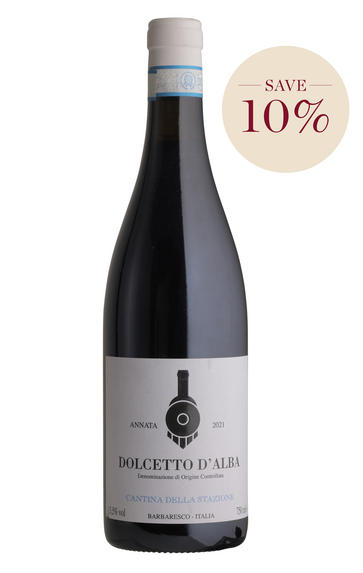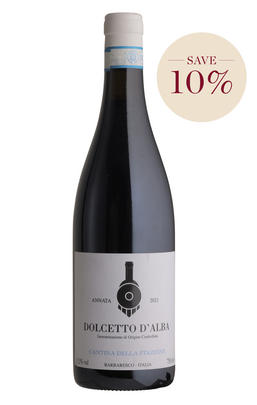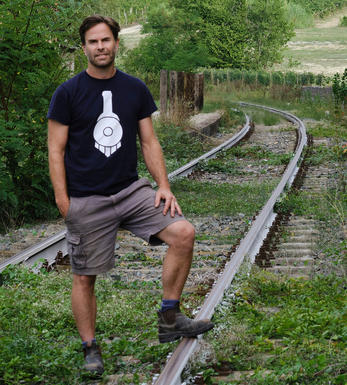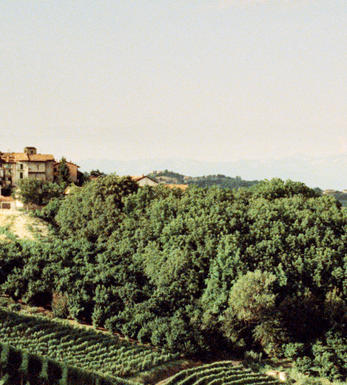
2021 Dolcetto d'Alba, Cantina della Stazione, Fletcher, Piedmont, Italy

Critics reviews
Cantina della Stazione is the new négociant line from Dave Fletcher (Fletcher Wines), and 2021 is the first vintage of this range. The Bricco Capre vineyard is above the San Rocco Seno d'Elvio village and almost overlooks Alba. The average age of vines is 60 years. Spontaneous fermentation in open vats. Not fined or filtered.
Violet crimson. Gorgeous blueberry and blackberry fruit with floral lift and vibrant acidity. Bags of crunchy blackberry fruit with cracking, long-lasting tannins. It will be fascinating to see this age.
Drink 2022 - 2028
Walter Speller, JancisRobinson.com (August 2022)
About this WINE

Fletcher Wines
An Australian winemaker living in Piedmont? Dave Fletcher has been entranced by Nebbiolo since he first tasted Barolo in Australia in 2004. He landed a stage at Ceretto in 2007, joining as their winemaker in 2012. He guided them towards a less oak-dependent style, in favour of finesse and subtlety. He started to make wines under his own label in Barbaresco from the ’09 vintage. In 2014, he and his wife Eleanor bought the old Barbaresco stationmaster’s house in an auction, consequently laying roots in the region.
Situated at the foot of the Martinenga vineyard, close to the great Asili site, the rather dilapidated building came with barrel-vaulted brick cellars under the house. Its restoration continues but its facilities have proved ideal for Dave and the scale of his operation.

Piedmont
Piedmont has long been renowned as Italy's premier fine wine province, with its reputation dating back to Roman times and further solidified under the House of Savoy, which wielded influence over Europe during the Middle Ages from its Turin stronghold. Piedmont's prominence in Italian history was notably highlighted as a driving force behind Italian Reunification in 1861.
Situated in the north-western part of Italy, Piedmont boasts a continental climate shaped by the nearby Alps and Ligurian Apennines, influencing both its culture and winemaking traditions. The region is home to several renowned fine wine areas, including the Langhe region, encompassing esteemed appellations such as Barolo and Barbaresco, as well as Monferrato, which features wines like Asti and Gavi, and Novara with its Colline Novaresi and Boca.
Nebbiolo reigns supreme as Piedmont's quintessential grape variety, with its stronghold in the production of illustrious wines such as Barolo and Barbaresco. Following closely are Barbera d'Alba or Barbera d'Asti, and Dolcetto, known for its role as an early-ripening antipasti wine, particularly around Dogliani. Among whites, Moscato takes center stage, crafting both the effervescent Asti and the more refined Moscato d'Asti.
Piedmont also produces notable red wines like Brachetto d'Acqui and popular dry whites such as Gavi, made from the Cortese grape. Remarkably, despite contributing only a small fraction to Italy's total wine production, Piedmont boasts the highest proportion of Denominazione di Origine Controllata (DOC) and Denominazione di Origine Controllata e Garantita (DOCG) wines.
For those seeking exceptional Piedmontese wines, recommended producers include Roberto Sarotto, Marinacci, Punset, Luisin, Roagna, Fratelli Alessandria, Trediberri, Vigneti Luigi Oddero, Marcarini, and E.Pira di Chiara Boschis, among others.

Nebbiolo
Nebbiolo is the grape behind the Barolo and Barbaresco wines and is hardly ever seen outside the confines of Piedmont. It takes its name from "nebbia" which is Italian for fog, a frequent phenomenon in the region.
A notoriously pernickety grape, it requires sheltered south-facing sites and performs best on the well-drained calcareous marls to the north and south of Alba in the DOCG zones of Barbaresco and Barolo.
Langhe Nebbiolo is effectively the ‘second wine’ of Piedmont’s great Barolo & Barbarescos. This DOC is the only way Langhe producers can declassify their Barolo or Barbaresco fruit or wines to make an early-drinking style. Unlike Nebbiolo d’Alba, Langhe Nebbiolo can be cut with 15% other red indigenous varieties, such as Barbera or Dolcetto.
Nebbiolo flowers early and ripens late, so a long hang time, producing high levels of sugar, acidity and tannins; the challenge being to harvest the fruit with these three elements ripe and in balance. The best Barolos and Barbarescos are perfumed with aromas of tar, rose, mint, chocolate, liquorice and truffles. They age brilliantly and the very best need ten years to show at their best.


Buying options
Add to wishlist
Description
The price of the 75cl bottle, reduced from £22.50 previously, includes a 10% discount. This offer does not apply to BBX listings.
Cantina della Stazione is the new négociant line from Dave Fletcher (Fletcher Wines), and 2021 is the first vintage of this range. The Bricco Capre vineyard is above the San Rocco Seno d'Elvio village and almost overlooks Alba. The average age of vines is 60 years. Spontaneous fermentation in open vats. Not fined or filtered.
Violet crimson. Gorgeous blueberry and blackberry fruit with floral lift and vibrant acidity. Bags of crunchy blackberry fruit with cracking, long-lasting tannins. It will be fascinating to see this age.
Drink 2022 - 2028
Walter Speller, JancisRobinson.com (August 2022)
wine at a glance
Delivery and quality guarantee